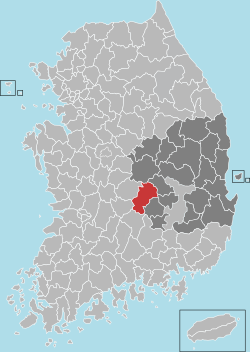Gimcheon
김천시 | |
|---|---|
| Korean transcription(s) | |
| • Hangul | 김천시 |
| • Hanja | 金泉市 |
| • Revised Romanization | Gimcheon-si |
| • McCune-Reischauer | Kimch'ŏn-si |
 Gimcheon City Hall | |
 Location in South Korea | |
| Country | |
| Region | Yeongnam |
| Administrative divisions | 1 eup, 14 myeon, 7 dong |
| Area | |
| • Total | 1,009.5 km2 (389.8 sq mi) |
| Population (September 2024[1]) | |
| • Total | 135,767 |
| • Density | 150/km2 (400/sq mi) |
| • Dialect | Gyeongsang |
| Time zone | UTC+9 (Korea Standard Time) |
| Area code | +82-54 |
| Website | Official website (English) |
Gimcheon (Korean: 김천; lit. gold spring; Korean pronunciation: [kim.tɕʰʌn]) is a city in North Gyeongsang Province, South Korea. It is situated on the major land transportation routes between Seoul and Busan, namely the Gyeongbu Expressway and Gyeongbu Line railway.
In ancient times, Gimcheon was famous for its three mountains (Geumo, Daedeok, Hwangak) and two rivers (Gamcheon, Jikjicheon). During the Chosun Dynasty, Gimcheon had one of the five largest markets in the region. The town has also served as the gateway and traffic hub of the Yeongnam region and is particularly proud of its patriots, history and conservative lifestyle.
The slogan of Gimcheon city is 'Central Gimcheon', a recognition of the fact that it is situated almost at the center of South Korea.
- ^ "Population statistics". Korea Ministry of the Interior and Safety. 2024.

